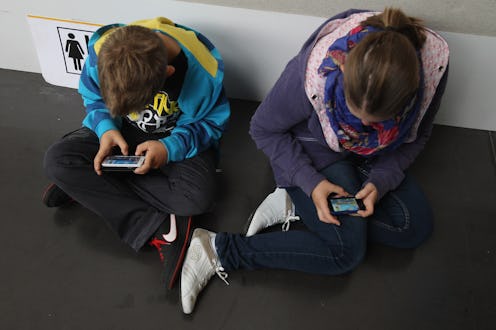Life
These Apps Could Make You A Cell Phone Addict

As cell phones have become increasingly ubiquitous, so has cell phone addiction. We've come to rely on our phones for an increasing number of tasks… checking emails, reading books, listening to music, updating social media, and more. But the increased utility seems to have led to an increase in dependency, and a new study from the Journal of Behavioral Addictions claims that cell phone addiction is common among college students.
Even though we already know that we use our cell phones an excessive amount — studies earlier this year found that one in 20 young adults checks their cell phones once a minute — researchers from Baylor University aimed to find which specific smart phone activities were most addictive.
The study surveyed 164 Baylor undergrads as part of their class requirements. Thankfully, the researchers found that students were checking their phones less than once a minute. Women clocked in at 600 minutes, or 10 hours, of cell phone use a day, while men used their phones for 459 minutes, or seven and a half hours. Still, these time estimates seem exceedingly high... what college student has time to be on their phone for 10 hours a day and go to class, eat meals, do homework, and party? It seems as though because these numbers are self-reported, they could be inaccurate. Perhaps the researchers also did not account for how often we millennials multitask on our phone, or that even if we are checking our phone once a minute, it's still only for a second and then we have the following 59 seconds to do other things with our lives.
So what apps are most addictive? The study found that for males, visiting Facebook, Twitter and Instagram, checking emails, reading books, sending texts and making phone calls were all activities that lead to increased cell phone addiction. Other activities, such as visiting Amazon, using the cell phone as a clock, and “other” applications seemed to reduce the likelihood of possible addiction. For females, using Pinterest, Instagram, and Amazon, making calls and sending text messages all were predictors of a possible cell phone addiction. In contrast, using Twitter and Pandora/Spotify seemed to have a negative effect on cell phone addiction. Overall, the data suggested that the time a user spends on social media sites such as Facebook and Instagram is a good indicator of a possible cell phone addiction.
However, the Huffington Post points out that this perceived addiction is perhaps just the modern way of keeping in touch and staying social in our new hyper-connected and consistently interactive world.
The study also suggested that while men see cell phones as a source of entertainment and information, women use their phones as a means of communication. This logic is also used to explain why women are supposedly more addicted to their cell phones than men, who are traditionally more invested in technology, because females are seen as using cell phones to achieve social goals.
Whether you believe in the possibility of cell phone addiction or not, it's important to evaluate how much we depend on our phones. Using it to keep in touch with your friends and text about the latest cat meme you found on Buzzfeed seems standard, but it you find yourself sitting amongst your best friends and you all have your phones to your faces, it may be time to self-evaluate.